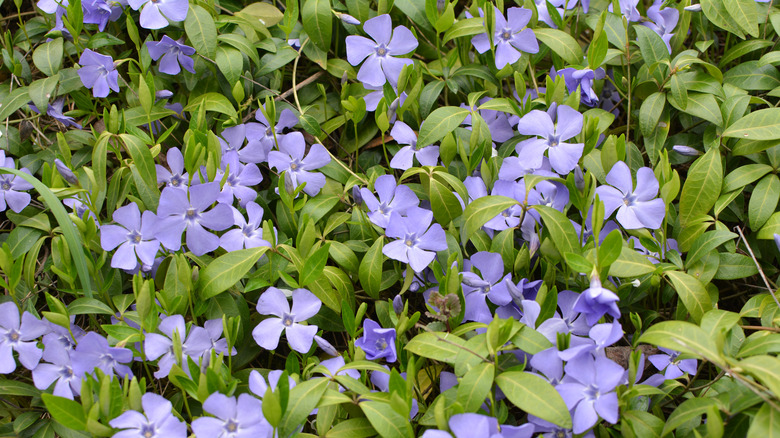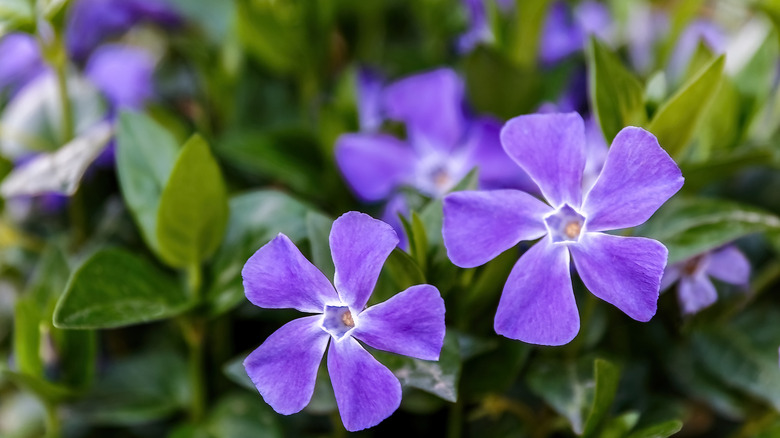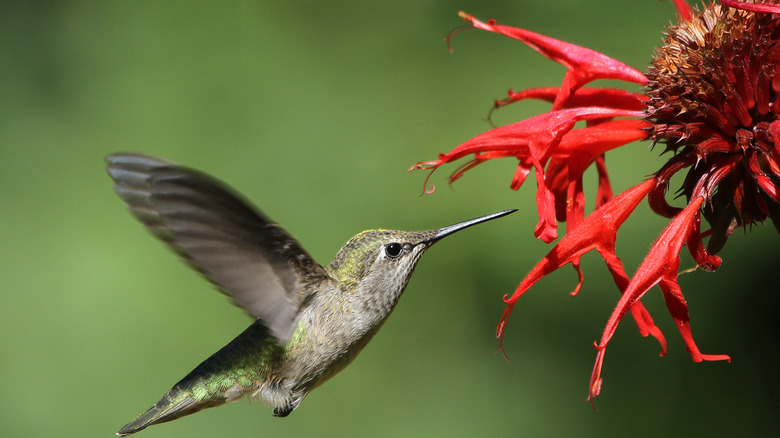Why You Want To Be Cautious Before Planting Periwinkle
Gardeners should exercise caution when considering planting periwinkle in their yard due to its invasive nature. While periwinkle is attractive with its ground cover and vibrant blue or white flowers, it can quickly establish itself and spread aggressively, out-competing native plants and disrupting local ecosystems. Its fast spread and ability to form dense mats hinder the growth of native vegetation, depriving wildlife of crucial food sources and habitat.
Once periwinkle becomes established, controlling its growth can be difficult as it propagates through both seeds and creeping stems. This invasiveness can lead to decreased biodiversity and soil erosion. In regions with a history of invasive species, introducing periwinkle can worsen existing issues. To maintain a balanced and healthy ecosystem, gardeners should choose native plant alternatives that support local wildlife and maintain the natural balance of the area. If periwinkle is already present on your property, practice careful management and containment to prevent its unchecked spread.
How to tame periwinkle
If you already have periwinkle growing in your yard, it is important to take precautions to control its growth. Start by assessing the extent of the periwinkle infestation to determine the level of intervention needed. One approach is to use physical barriers such as edging or root blockers to confine periwinkle, preventing it from spreading into areas where native species should thrive. Selective removal is also crucial – gradually eliminate periwinkle from targeted sections, allowing native plants to establish themselves. Additionally, manual uprooting of periwinkle both above and below the ground may be necessary.
Another intervention involves applying a thick layer of mulch over desired areas to suffocate periwinkle and impede its growth. Consistency is key – regularly monitor and remove new periwinkle growth. Introduce regionally suitable native plants, such as blue-eyed grass or prairie dropseed, to encourage natural competition and discourage periwinkle expansion. Another option is to improve the soil with organic matter to create favorable conditions for native species that can outcompete periwinkle. If possible, avoid using chemicals as they can harm desired plants and the environment.
It is important to remain vigilant and continue checking for any resurgence of periwinkle even after successful management. Educating neighbors and fellow gardeners about the invasive nature of periwinkle can help prevent its spread beyond your yard. By implementing these measures, you can reclaim your yard from the dominance of periwinkle and promote a thriving ecosystem of native plants.
Native plants to replace periwinkle with
A great alternative to periwinkle is Eastern columbine. This native perennial plant is known for its unique and intricate red and yellow flowers that resemble hanging lanterns. It thrives in partial shade to full sun and is well-suited for woodland gardens or shaded areas. Columbine provides nectar for hummingbirds and bees, contributing to pollinator diversity. Its delicate foliage adds aesthetic appeal while creating habitat and food sources for local insects. By cultivating Eastern columbine, you not only enhance the visual appeal of your yard but also support native pollinators.
Wild bergamot, also known as bee balm, is a striking native plant with clusters of lavender to purple flowers atop tall stems. It prefers sunny spots and well-drained soils. This plant attracts a wide range of pollinators, including bees, butterflies, and hummingbirds, making it an excellent addition to pollinator gardens. Wild bergamot has pleasant aromatic foliage and has historical uses in herbal remedies. By incorporating wild bergamot, you foster a vibrant pollinator-friendly environment and add a touch of native charm to your yard.
Lastly, the Virginia bluebell is a delightful plant with bell-shaped, sky-blue flowers that emerge before the tree canopy fully develops. It thrives in moist, shaded woodland areas. This plant not only offers early-season color but also benefits early emerging pollinators. Its foliage disappears in summer, allowing other plants to take the spotlight. Virginia bluebell's preference for shaded areas makes it an ideal choice for underplanting trees.


